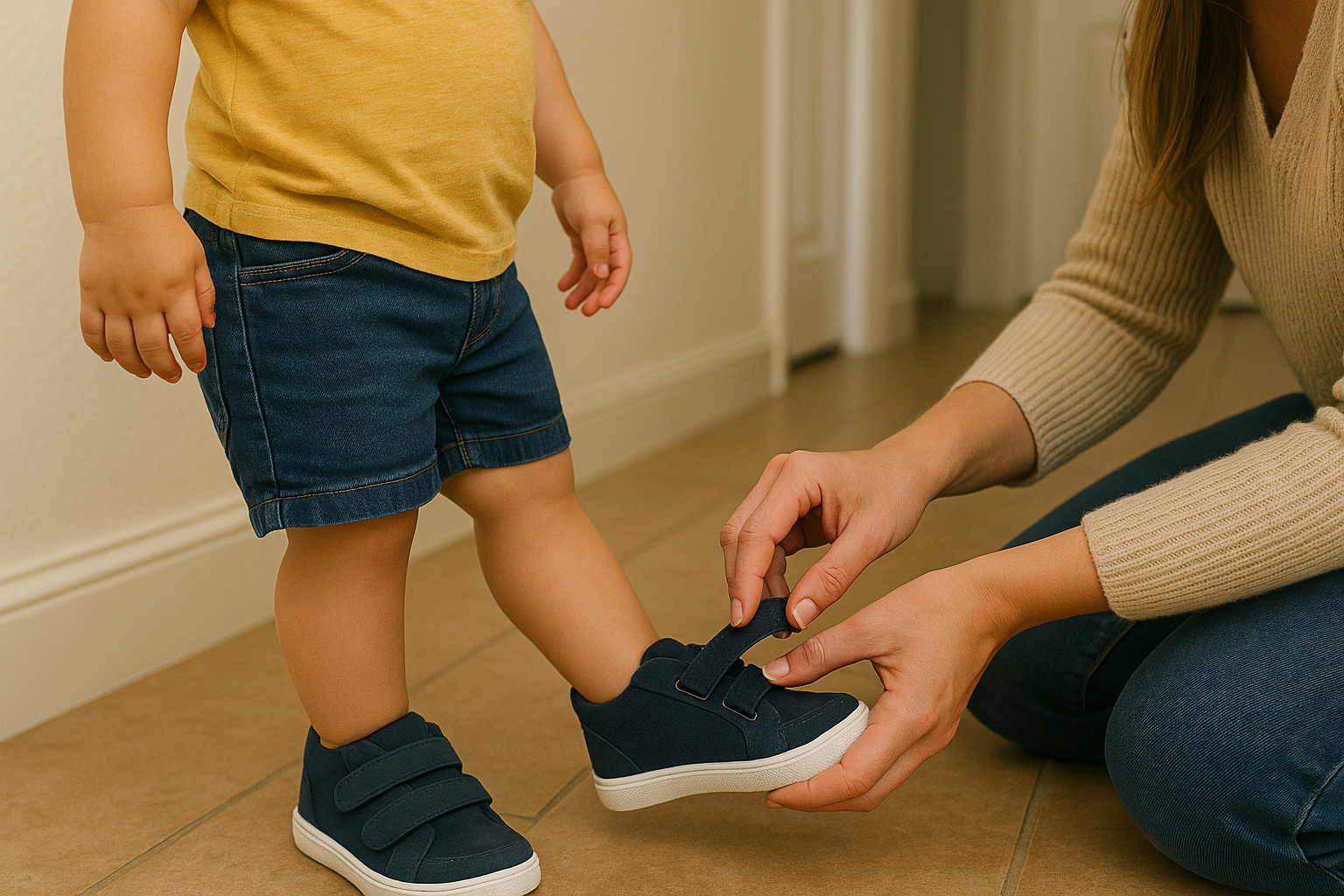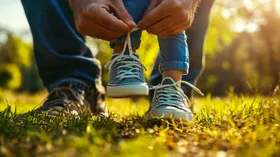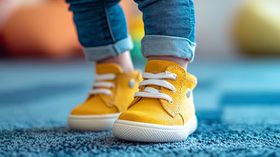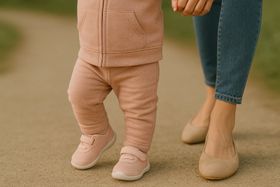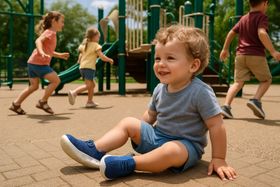Leg Length Difference in Kids: Causes & Safe Fixes
Small leg length differences under 1 cm are common and harmless in children. Larger differences may cause limping, hip pain, or difficulty with activities and can be managed with exercises, shoe lifts, or in severe cases, medical intervention depending on the cause and severity.
Published October 11, 2025
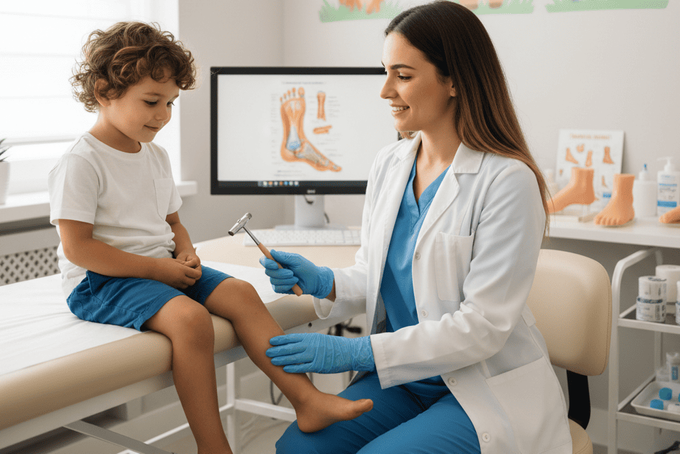
If you've noticed one of your child's legs looks longer than the other, you're not alone. About one-third of people have a leg length difference of 1 cm or less—a harmless variation that needs no treatment.
Differences under 2 cm rarely affect daily activities and often respond well to simple home strategies. Larger differences may need professional care, but with early attention, most children stay active and develop normally.
Let's look at what causes leg length differences in children, which symptoms need a doctor's visit, and how you can support your child's healthy development.
What Causes Leg Length Difference In Children
Leg length discrepancy (LLD) happens when one leg is shorter than the other. The difference ranges from barely noticeable to significant enough to affect movement [1].
- Congenital causes of underdevelopment of thigh or shin bones during fetal development are the most common [2]. Physical injuries causing bone fractures can disrupt growth plate development, preventing normal bone growth on the affected side.
- Neuromuscular conditions like cerebral palsy cause leg length differences through muscle stiffness and abnormal growth [3]. Sometimes, poor posture, muscle imbalances, or toe-walking habits make one leg appear shorter without actual bone differences.
- Less common but important causes include bone infections (osteomyelitis), growth disorders like Blount's disease or Perthes disease, and inflammatory conditions affecting growth plates.
- Growth plate injuries from fractures can damage cells facilitating bone growth, causing the plate to ossify too early or distribute load unevenly.
Expert Note: While this list might sound concerning, remember that most leg length differences respond well to treatment, and many small differences require no intervention at all.
Different Length Legs Symptoms You Will Notice At Home
You'll often spot signs before taking formal measurements.
- Limping becomes noticeable. Your child may toe walk on the shorter leg side, especially during or after active play. This movement becomes more obvious when they're tired.
- Frequent falls and hip dropping occur. The shorter leg can't match the longer one's function, creating an imbalance during walking or running. You might notice your child's hip drops on the shorter side when standing, with the tilt appearing at shoulder level, too.
- Clothing fits unevenly. One trouser leg consistently looks longer, or their shoes don't fit both feet evenly. Your child may put more effort into walking, running, or jumping than other children their age.
When Leg Length Differences Need Professional Care
Small differences are normal. Differences under 1 cm are often undetectable and don't require treatment. Temporary differences under 10 mm during growth spurts are also normal—one leg may temporarily outpace the other before evening out.
Seek professional evaluation when:
- Differences reach 2 cm or more, potentially causing discomfort, affecting your child's quality of life
- Visible foot deformities or postural deviations appear
- Walking patterns change, particularly persistent limping without pain after rest
- Your child becomes reluctant to play or complains of hip or back pain
- One leg appears to grow at a different rate than the other
How To Fix Your Child's Different Leg Lengths
For mild leg length differences under 2 cm not affecting activities, you can safely implement home strategies.
1. Exercises for Functional Differences To Fix Different Leg Lengths
- Stretching: Lunges (shorter leg kneeling, normal side forward) stretch quadriceps; standing forward bends stretch hamstrings
- Strengthening: Clamshells, bridges, heel raises build balanced muscle strength
- Balance Training: Standing on one leg (eyes open, then closed) improves stability
For younger children, try passive stretches while lying down; small sandbag weights tied to ankles during play add strengthening.
2. Movement Through Play To Fix Different Leg Lengths
- Weight cuffs during playtime naturally encourage strength training
- Animal movements (crawling, frog jumping, bear walking, bunny hopping) improve gait patterns
- Target-based activities like jumping to reach goals or hanging from monkey bars
- Ball-kicking games engage both legs equally
3. Proper Nutrition To Fix Different Leg Lengths
Getting your child to eat healthy foods with adequate calcium (700-1,300 mg daily depending on age), vitamin D (400-600 IU daily), and phosphorus supports healthy bone and growth plate development, helping prevent conditions like rickets that cause deformities [4].
Shoe Solutions for Leg Length Difference In Children
When it comes to shoe lifts, they balance leg lengths, promoting symmetry at the pelvis and shoulder levels. This decreases limping, distributes weight evenly, and protects against joint pain.
Internal lifts:
- Hidden inside shoes, less noticeable to children
- Affordable and easily adjusted
- Work for differences up to 2 cm
- May cause crowding if the lift is too high
External lifts:
- Handle larger corrections effectively
- Provide space for proper foot alignment
- More durable shoes for active play
- More expensive and visibly different
Orthotics work well for children with flat feet plus leg length differences, preserving normal foot structure and improving gait patterns.
Specialized orthopedic footwear for moderate to severe differences includes built-in lifts matched to exact measurements, deep heel cups, and arch support for proper alignment, and durable construction handling active play.
You will need to introduce height corrections gradually:
- Start with half the total lift height needed
- After 1-2 months, increase to 75% of total height
- Continue monitoring for another 1-2 months
- Gradually add the remaining height to the full correction
This prevents discomfort and helps your child's body adapt naturally.
Professional Treatment for Shortened Leg And Larger Discrepancies
How treatment works based on the difference:
- Mild (Under 2 cm): Home exercises and orthopedic support usually do the job
- Moderate (2-5 cm): Professional physical therapy is combined with custom orthopedic footwear
- Severe (Over 5 cm): Surgical interventions like epiphysiodesis (slowing growth in the longer leg) or limb lengthening procedures will be done
How long does treatment take?
- Exercise interventions take at least 4 weeks to show changes
- Full functional improvement requires 3-6 months of consistent work
- Surgical recovery takes 6-12 months, depending on your child's age and how well post-operative care is followed
Expert Note: Patience is important throughout this process. Expect gradual improvements rather than an overnight transformation.
Remember, your pediatrician will monitor your child's progress at regular check-ups and will let you know if there's any cause for concern. Most children do remarkably well with appropriate support.
Growth Monitoring At Critical Ages for Different Leg Lengths
Different ages need different attention when watching for leg length differences.
- During the ages 0-3, walking is still developing. Watch for trouble with cruising or if your baby's posture seems off. This transition from crawling or bottom shuffling to walking is when you'll notice early signs.
- Between ages 4-10, legs grow rapidly and differences become more obvious. You might notice one trouser leg looks consistently longer, or your child's hip tilts when they stand. Pay attention to how they walk and run—it tells you a lot about whether they're comfortable.
- Ages 11-16 are when growth plates start closing. By now, you'll have a clearer picture of whether intervention might be needed or if things have evened out on their own.
Check in monthly during those early years when growth happens fast. Your pediatrician will do proper measurements at regular visits and let you know if anything needs closer attention.
Long-Term Outlook for Children With Leg Length Difference
Most children with leg length differences do really well with the right support.
Exercises and supportive footwear help minimize any symptoms while keeping your child active and comfortable. If surgery is needed, it does take time for recovery and relearning movement patterns, but outcomes are generally very positive.
With sports, children with small differences usually play everything without problems. Moderate differences might make rough sports like football uncomfortable, but swimming and cycling typically feel fine.
Larger differences may need addressing before full sports participation, but most children get back to normal activity after treatment.
Here's something important to note. Back and joint problems later in life can often be prevented by catching and managing leg length differences early.
When weight stays balanced, your child's body develops more evenly. The earlier you spot and address issues, the better things turn out long-term.
Prevention And Support for Children With Leg Length Differences
You can't prevent differences your child is born with, but you can reduce other risks.
- Keep an eye on how your child moves and plays. If they break a bone, make sure it heals properly, and keep them gently active during recovery—prolonged rest can affect growth
- Keep play areas safe to prevent injuries
- Feed them well with plenty of calcium, vitamin D, and the nutrients growing bones need
- Let them play actively—running, jumping, and moving helps bones grow strong
Don't forget the emotional side. Your child might feel awkward about limping or wearing special shoes. They might worry about looking different from their friends.
Listen when they share these feelings. Help them feel confident by focusing on what they can do, not what's different. Encourage them to join in activities and remind them that lots of kids manage similar challenges. Your reassurance and support matter more than you might think.
Supporting Your Child's Healthy Development With Leg Length Difference
Most children with mild leg length differences do well with home exercises, supportive footwear, and regular check-ins. Larger differences need professional care. The key is to watch how your child moves and listen when something feels off.
Remember, your pediatrician checks your child's leg length and development at every well-child visit. If there's anything concerning, they'll let you know and guide you on the next steps. Most of the time, small differences are completely normal and need no special treatment at all.
Proper footwear makes a real difference as your child grows. First Walkers orthopedic shoes provide the support, alignment, and custom modifications (like heel lifts) that children with leg length differences need. The right shoes help your child move confidently and comfortably through their day.
References
Applebaum, A., Nessim, A., & Cho, W. (2021). Overview and spinal implications of leg length discrepancy: Narrative review. Clinics in Orthopedic Surgery, 13(2), 127. https://doi.org/10.4055/cios20224
Hospital for Special Surgery. (2022, August 29). Leg length discrepancy. https://www.hss.edu/health-library/conditions-and-treatments/list/leg-length-discrepancy
Vogt, B., Gosheger, G., Wirth, T., Horn, J., & Rödl, R. (2020). Leg Length Discrepancy— Treatment Indications and Strategies. Deutsches Ärzteblatt International. https://doi.org/10.3238/arztebl.2020.0405
Cosenza, L., Pezzella, V., Nocerino, R., Di Costanzo, M., Coruzzo, A., Passariello, A., Leone, L., Savoia, M., Del Puente, A., Esposito, A., Terrin, G., & Canani, R. B. (2013). Calcium and vitamin D intakes in children: a randomized controlled trial. BMC Pediatrics, 13(1). https://doi.org/10.1186/1471-2431-13-86
Disclaimer: First Walkers' information is intended for educational and informational purposes related to toddler footwear and feet. We encourage you to consider individual circumstances and consult qualified orthopaedists about specific conditions.
FAQs
How serious is my child's leg length difference?
It depends on the size and impact. Differences under 1 cm are harmless and extremely common. Differences of 1-2 cm are mild and manageable with exercises and supportive footwear. Anything over 2 cm should be assessed by a pediatrician to determine the best approach.
Is this a permanent problem, or will my child outgrow it?
Functional differences from muscle imbalances often improve with physical therapy. Temporary differences under 10 mm during growth spurts usually even out naturally. Congenital differences in bone structure won't resolve on their own but can be managed successfully with footwear or surgery.
Will my child be able to play sports normally?
Mild differences under 2 cm rarely limit sports participation. Moderate differences may make high-impact activities uncomfortable, but they usually respond well to proper footwear modifications. Severe differences may limit sports until surgical correction, after which most children return to full activity.
Can leg length difference affect my baby's ability to learn to walk?
Small differences rarely delay walking. Significant differences may cause your baby to develop compensatory patterns like toe-walking. If you notice struggles with pulling up or unusual walking patterns, mention this at your pediatric visit for early support.
How often should I measure my child's legs at home?
Monthly checks work well for children under 3 during rapid growth. Ages 4-10 need checking every 2-3 months. After age 11, every 3-6 months is sufficient. Watch your child's movement and function more than precise measurements—these signs often tell you more.
